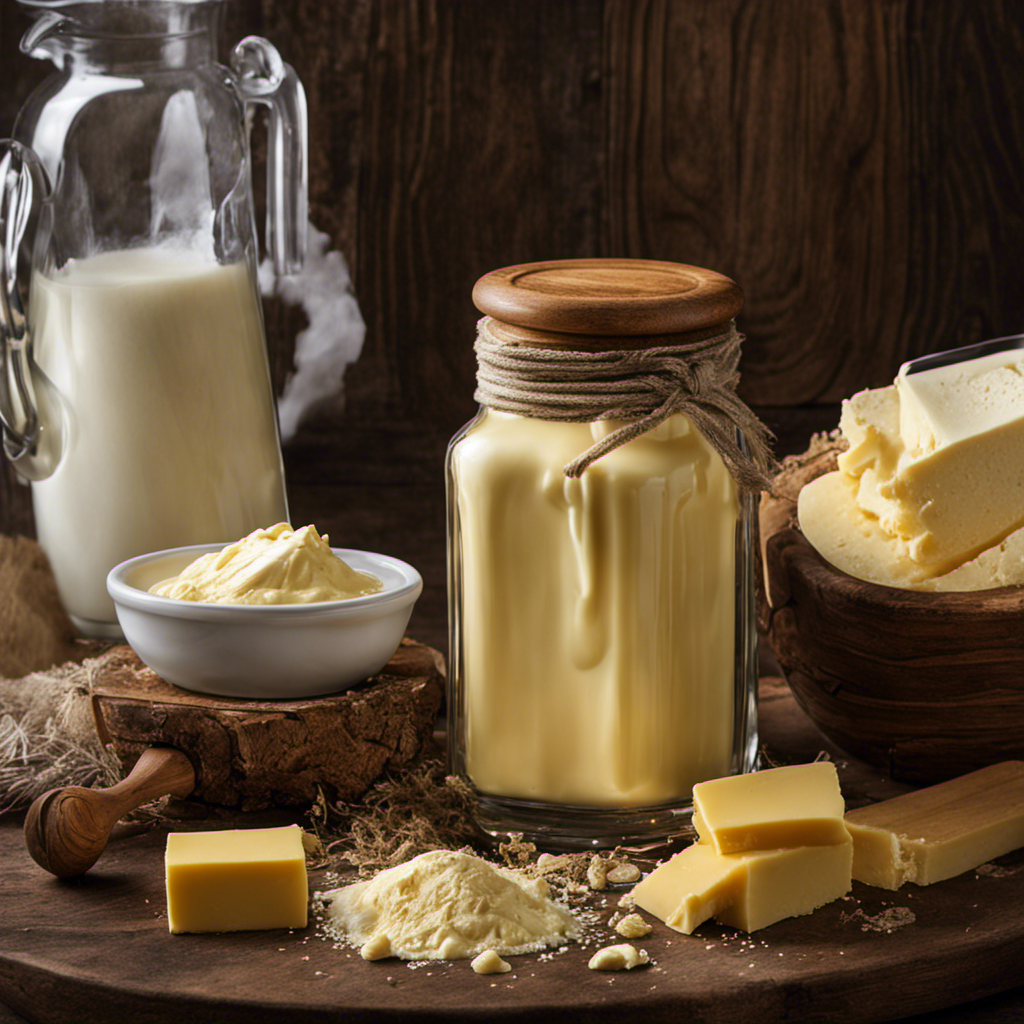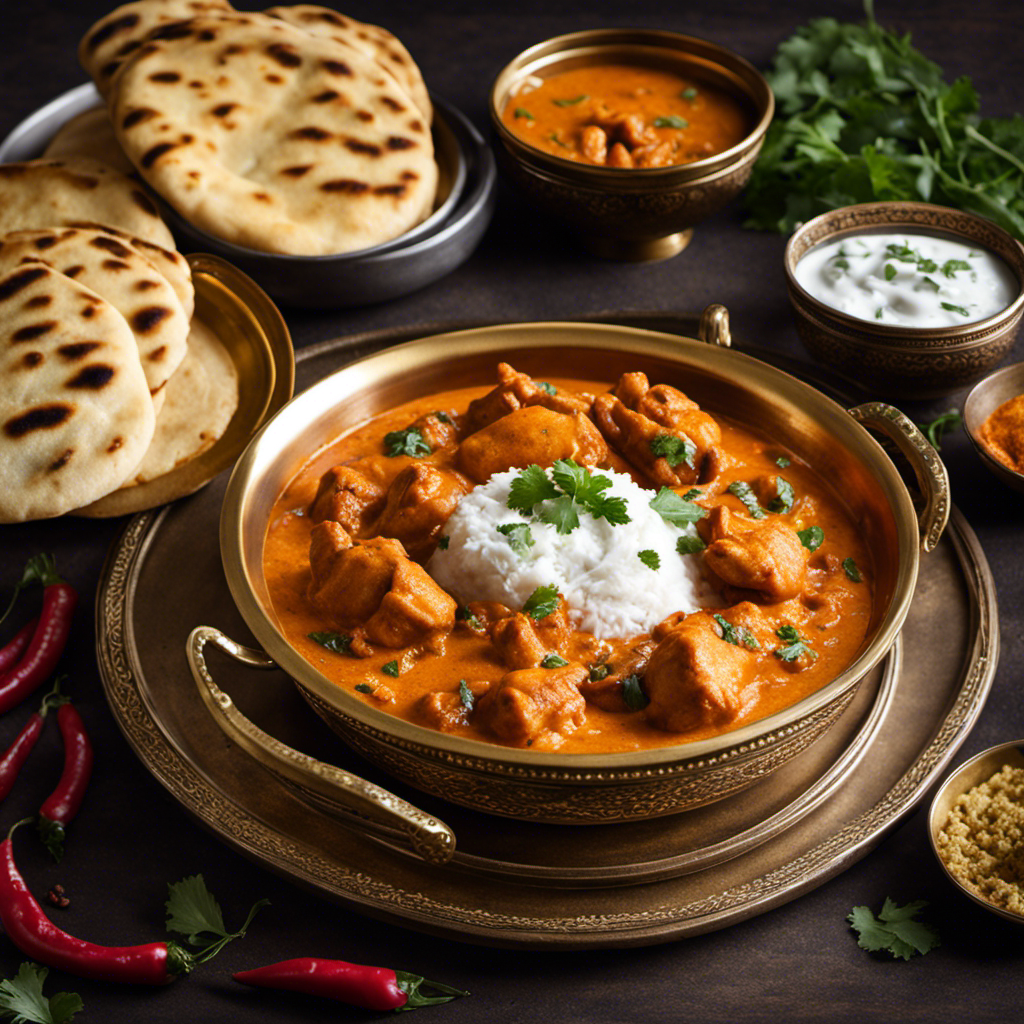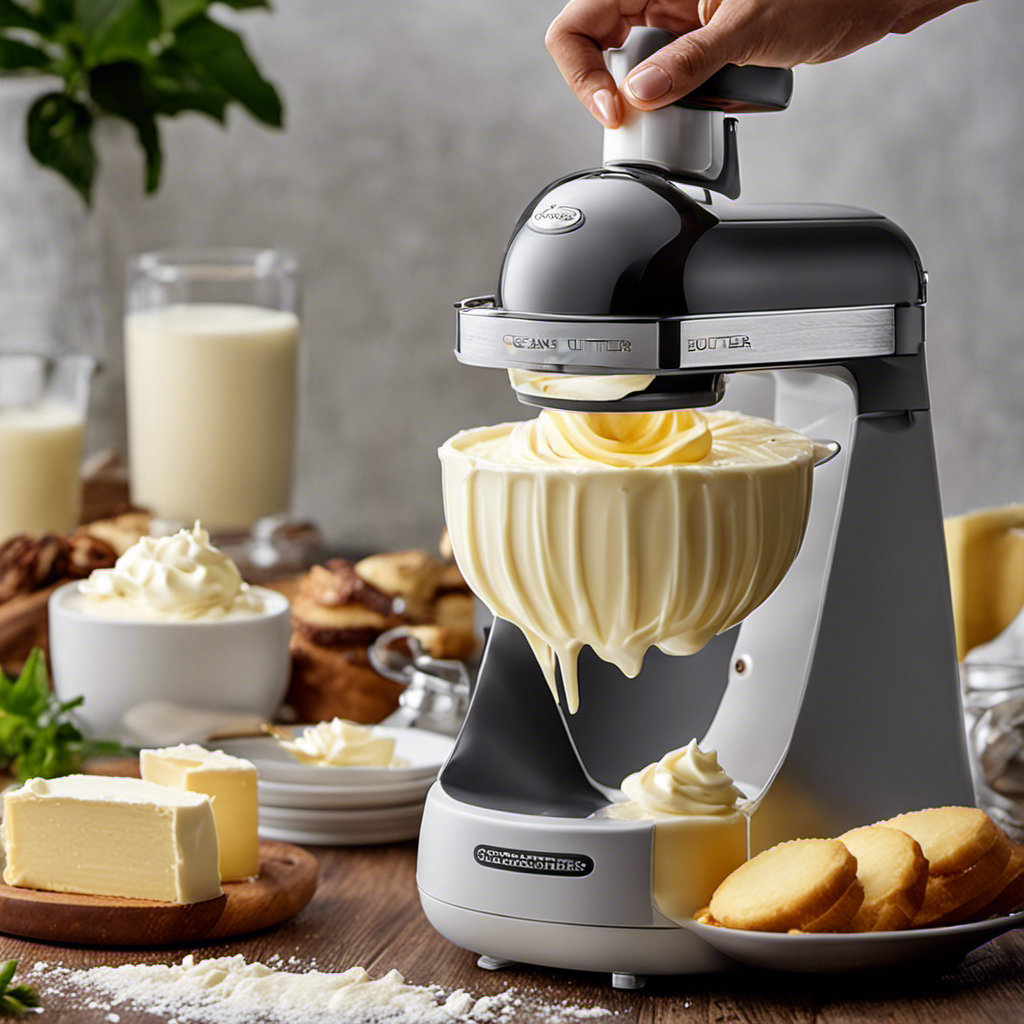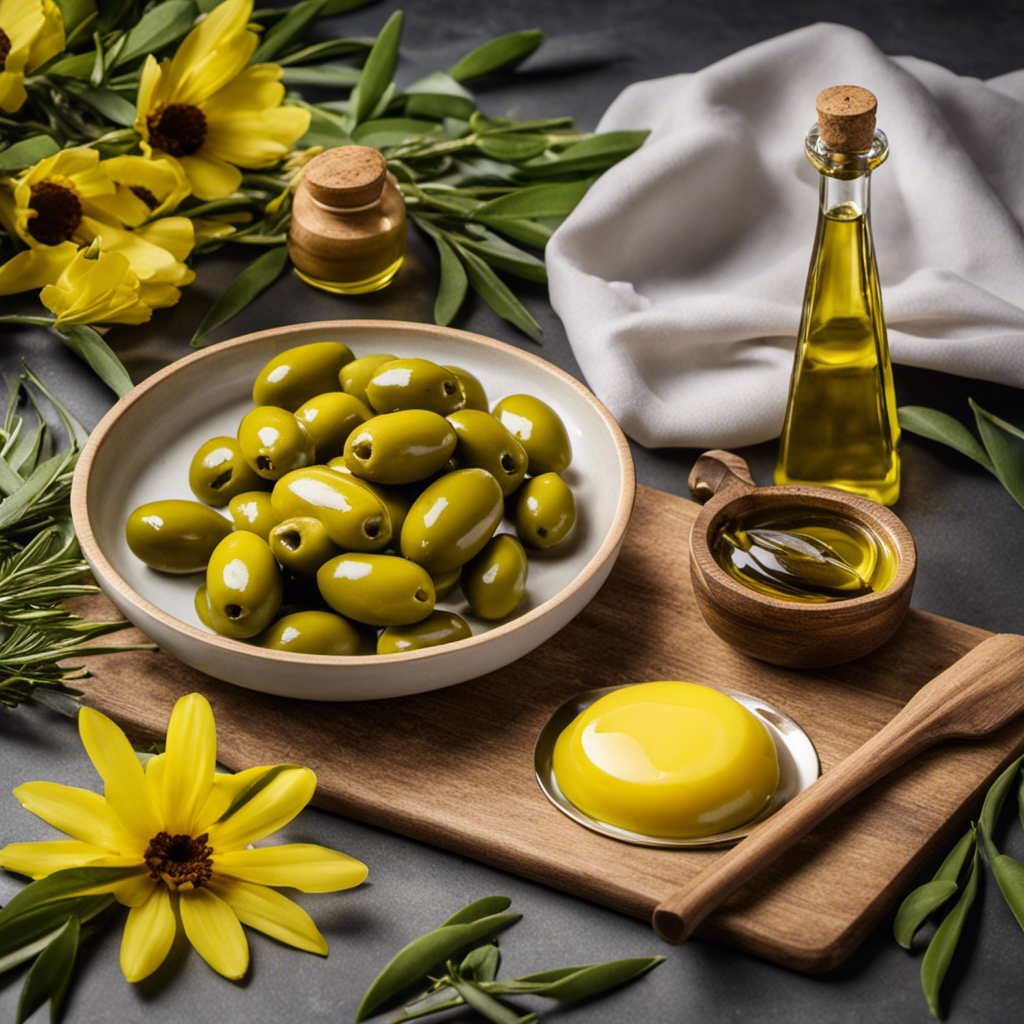As a cooking enthusiast who has frequently dealt with the annoyance of butter stains on my garments, I fully grasp the challenge.
But fear not! In this article, I’ll share my tried and true methods for getting butter out of clothes.
From immediate steps to take when the mishap happens to homemade stain removers and tips for preventing future stains, I’ve got you covered.
So, let’s dive in and bid those pesky butter stains farewell once and for all!
Key Takeaways
- Different fabrics require different techniques for removing butter stains.
- Immediate steps to take for butter stains include blotting, using cornstarch or talcum powder, and applying dishwashing liquid or grease-fighting laundry detergent.
- Both homemade solutions like vinegar or lemon juice and store-bought stain removers can effectively remove butter stains.
- Effective stain removal techniques include using natural remedies, store-bought solutions, DIY techniques, and enzyme-based, oxygen bleach, or solvent-based detergents.
Types of Butter Stains
There are several types of butter stains that can be difficult to remove from clothes. As someone who has dealt with countless butter stains over the years, I have learned that different fabrics require different techniques for removal.
For example, removing butter stains from delicate fabrics like silk or chiffon can be particularly challenging. These fabrics are prone to absorbing the greasy residue, making it harder to eliminate the stain completely. However, with the right approach, it is possible to restore your delicate garments.
In the following section, I will share some effective butter stain removal techniques specifically tailored for delicate fabrics. By following these methods, you can ensure that your delicate clothes stay in pristine condition while bidding adieu to those stubborn butter stains.
Now, let’s discuss the immediate steps to take.
Immediate Steps to Take
Start by gently blotting the stained area with a clean cloth or paper towel. This will help to remove any excess butter and prevent it from spreading further into the fabric.
It’s important to act quickly when it comes to grease stains, as they can be quite stubborn if left untreated.
After blotting, you can sprinkle some cornstarch or talcum powder onto the stain to absorb any remaining grease. Let it sit for a few minutes before brushing it off.
If the stain persists, you can try applying a small amount of dishwashing liquid or a grease-fighting laundry detergent directly onto the stain. Gently rub it in with your fingers, and then rinse the area with warm water.
With these emergency stain removal steps, you can effectively tackle butter stains and prevent them from ruining your clothes.
Removing Butter Stains From Different Fabrics
To remove butter stains from different fabrics, it’s important to consider the type of fabric and choose the appropriate cleaning method.
For delicate fabrics like silk or wool, start by gently scraping off any excess butter with a dull knife or spoon. Then, apply a small amount of dishwashing liquid to the stain and gently rub it in with your fingertips. Let it sit for a few minutes before rinsing with cold water.
For tougher fabrics like cotton or polyester, try using a stain remover specifically designed for grease stains. These products contain enzymes that break down the fats in the butter, making it easier to remove. Always test the stain remover on a small, inconspicuous area of the fabric first to ensure it doesn’t cause any damage.
Preventing butter stains in the first place can save you a lot of trouble. One alternative use for butter stain removers is to apply them to fabric before washing, as a preventative measure. This can help create a barrier between the fabric and the butter, making it easier to remove any potential stains.
Homemade Butter Stain Removers
When it comes to removing butter stains, I have found that there are two main options: natural homemade solutions or store-bought stain removers.
In my experience, natural solutions like vinegar, lemon juice, or dish soap have been effective in breaking down the grease and removing the stain.
However, store-bought stain removers often contain specialized ingredients that can provide quicker and more targeted results.
Ultimately, the effectiveness of different methods may vary depending on the fabric and the severity of the stain, so it’s important to consider both options and choose the one that suits your needs best.
Natural Vs. Store-Bought Solutions
One option for removing butter stains from clothes is to compare natural and store-bought solutions. When it comes to effectiveness, both options have their pros and cons. Natural remedies are often gentle on fabrics and environmentally friendly, but their effectiveness may vary depending on the severity of the stain. On the other hand, store-bought solutions are specifically formulated to tackle tough stains like butter, offering a higher chance of success. However, they may contain harsh chemicals that can be damaging to certain fabrics or cause skin irritations. To help you compare the two options, here is a table outlining the pros and cons of homemade remedies:
| Natural Remedies | Store-Bought Solutions |
|---|---|
| Gentle on fabrics | Formulated for tough stains |
| Environmentally friendly | Higher chance of success |
| May vary in effectiveness | May contain harsh chemicals |
In my experience, I have found that a combination of natural and store-bought solutions works best for removing butter stains from clothes.
Effectiveness of Different Methods
In my opinion, a combination of natural and store-bought solutions is the most effective way to remove butter stains from clothes.
When it comes to removing butter stains, there are various methods available, including natural remedies and do-it-yourself (DIY) techniques.
Natural remedies like lemon juice, vinegar, and dish soap can be effective in breaking down the grease and removing the stain. However, they may not always be as potent as store-bought stain removers, which are specifically formulated to tackle tough stains.
DIY methods, such as using a butter knife or blotting the stain with a paper towel, can also be helpful in removing fresh butter stains. However, they may not be as effective on older or set-in stains.
Therefore, combining natural remedies with store-bought solutions provides the best chance for successfully eliminating butter stains from clothes.
Using Commercial Stain Removers
When it comes to using commercial stain removers, it is important to consider the effectiveness of different brands. Some brands may work better on certain types of stains, while others may be more versatile.
Additionally, safety considerations should be taken into account when using these products. It is essential to read and follow the instructions, use protective gloves if necessary, and keep the removers out of reach of children and pets.
Effectiveness of Different Brands
I’ve found that certain brands of stain remover are more effective at getting butter out of clothes than others. Through my experience dealing with various stains, I have discovered that some brands have a better track record when it comes to removing butter stains. Here is a comparison of the effectiveness of different brands:
| Brand | Effectiveness |
|---|---|
| Brand A | High |
| Brand B | Medium |
| Brand C | Low |
| Brand D | High |
As you can see, Brand A and Brand D are the most effective at removing butter stains, while Brand C is the least effective. Brand B falls somewhere in the middle. It’s important to note that the effectiveness of a stain remover can vary depending on the fabric and the age of the stain. However, these rankings are based on my personal experiences. While commercial stain removers can be effective, it’s also worth considering natural solutions, which have their own pros and cons.
Safety Considerations When Using
It’s important to consider safety when using different brands of stain remover. As someone who has dealt with countless stains on various types of fabric, I have learned the importance of taking safety precautions to avoid potential hazards. Here are three key safety considerations to keep in mind:
-
Read the instructions: Before using any stain remover, carefully read the instructions provided by the manufacturer. This will give you important information on how to properly use the product and any precautions you should take.
-
Test on a small, inconspicuous area: Before applying the stain remover to the entire stained area, test it on a small, hidden section of the fabric. This will help you determine if the product is safe to use and won’t cause any damage or discoloration.
-
Use in a well-ventilated area: Many stain removers contain chemicals that can release fumes. To avoid inhaling these potentially harmful substances, make sure to use the product in a well-ventilated area. Open windows or turn on fans to ensure proper airflow.
Pre-treating Butter Stains
To pre-treat butter stains on your clothes, you can use a small amount of dish soap and warm water. This method is one of the most effective butter stain removal hacks that I have come across.
The dish soap helps break down the butter’s greasy residue, while the warm water helps to lift the stain from the fabric. It is important to remember that when treating butter stains, you should avoid using hot water as it can set the stain and make it more difficult to remove.
Additionally, one of the common mistakes in treating butter stains is rubbing the stain vigorously, which can spread the butter and make the stain worse. Instead, gently blot the stain with a clean cloth or sponge to prevent further damage to the fabric.
Washing Butter Stained Clothes
When it comes to washing butter stained clothes, there are several key points to consider for effective stain removal.
First, it’s important to know the right techniques to remove the stain, such as using a pre-treatment or soaking the garment in a stain remover before washing.
Second, choosing the right detergent is crucial to ensure that the stain is fully removed without damaging the fabric.
Lastly, taking preventive measures can help avoid future butter stains, such as being cautious while eating or cooking with butter and immediately treating any stains that occur.
Effective Stain Removal Techniques
There are a few effective stain removal techniques you can use to get butter out of clothes. As someone who has dealt with countless butter stains, I can share some helpful tips. Here are three tried-and-true methods:
-
Homemade Stain Removers: Create a mixture of dish soap and warm water. Gently dab the solution onto the stain using a clean cloth. Let it sit for a few minutes, then rinse with cold water. Alternatively, you can make a paste with baking soda and water, apply it to the stain, and let it dry before washing.
-
Act Quickly: Don’t let the butter stain set! Blot the excess butter with a paper towel, being careful not to rub it further into the fabric. The sooner you act, the better chance you have at removing the stain completely.
-
Avoid Common Butter Stain Mistakes: Never use hot water on a butter stain as it can set the stain permanently. Also, avoid using bleach as it can cause discoloration. Instead, opt for cold water and gentle stain removal methods.
Choosing the Right Detergent
For the best results, consider using a detergent specifically formulated for removing tough stains like butter. There are different types of detergents available in the market, each with its own set of pros and cons. To help you choose the right detergent for your stain removal needs, here is a comparison table:
| Detergent Type | Pros | Cons |
|---|---|---|
| Enzyme-based | Highly effective in breaking down organic stains like butter. | May not be suitable for all fabric types. |
| Oxygen bleach | Gentle on fabrics and safe for colored clothes. | May not be as effective on tough stains. |
| Solvent-based | Great for grease and oil stains. | Can be harsh on delicate fabrics and may cause color fading. |
Preventing Future Butter Stains
To avoid future butter stains, it’s important to be mindful of what you’re eating while wearing delicate fabrics. Here are three tips for stain prevention:
-
Be cautious when consuming butter-rich foods: Butter is notorious for leaving stubborn stains on clothes. To prevent this, try to avoid eating greasy foods that are likely to result in spills or splatters.
-
Use protective measures: If you know you’ll be handling butter or greasy foods, consider wearing an apron or using a napkin as a barrier between your clothes and the food. This can help minimize the chances of stains.
-
Act quickly: Should a butter stain occur, it’s vital to address it promptly. Blot the stain gently with a clean cloth or paper towel to remove any excess butter. Then, treat the stain with a prewash stain remover or a mixture of dish soap and water. Rinse thoroughly and launder as usual.
Drying Butter Stained Clothes
If you’re in a hurry, use a hairdryer to speed up the drying process for butter stained clothes. The first step is to gently blot the stained area with a clean cloth or paper towel to remove as much excess butter as possible. Then, lay the garment flat on a clean towel and allow it to air dry. If you’re short on time, using a hairdryer on a low heat setting can help expedite the drying process. However, be careful not to apply too much heat, as it can set the stain and make it harder to remove.
Dealing With Lingering Butter Odor
To eliminate the lingering butter odor, you can try sprinkling baking soda on the affected area and letting it sit for a few hours before washing the garment. Baking soda is a natural deodorizer that can absorb and neutralize unpleasant smells.
Here are three additional tips to help you get rid of the lingering butter smell and remove any remaining butter residue from your clothes:
-
Vinegar solution: Mix equal parts of white vinegar and water, and apply it to the affected area. Let it sit for a few minutes before washing the garment as usual. Vinegar is known for its ability to break down fats and oils, making it effective in removing butter residue.
-
Lemon juice: Squeeze fresh lemon juice onto the butter stain, and gently rub it in. Lemon juice has natural bleaching properties that can help remove stubborn stains and eliminate odors.
-
Pre-treatment: Before washing the garment, pre-treat the butter stain with a stain remover or liquid laundry detergent. Apply the product directly to the stain, let it sit for a few minutes, and then wash the garment as usual. This will help ensure that the butter residue is thoroughly removed during the washing process.
Tips for Preventing Butter Stains
When cooking with butter, remember to be mindful of your movements to prevent accidental spills or splatters. This can help you avoid the hassle of dealing with butter stains on your clothes. However, if you do end up with a butter stain, there are alternative stain removers that can effectively remove the stain without damaging the fabric. One common mistake in stain removal techniques is rubbing the stain vigorously, which only spreads the butter further into the fabric. Instead, gently blot the stain with a clean cloth or paper towel to absorb as much of the butter as possible. Then, apply a stain remover specifically designed for grease stains and follow the instructions on the product. By being cautious and using the right stain removal techniques, you can successfully prevent and treat butter stains on your clothes.
| Preventing Butter Stains | Alternative Stain Removers |
|---|---|
| Be mindful of movements | Dish soap |
| Avoid spills and splatters | Baking soda |
| Blot gently, don’t rub | White vinegar |
| Use a grease stain remover | Lemon juice |
Final Thoughts and Additional Resources
In conclusion, it’s important to be cautious when cooking with butter to prevent any potential stains on your clothing. Here are some final thoughts and additional resources to help you deal with butter stains:
-
Act quickly: The sooner you treat a butter stain, the better your chances of removing it completely. Blot the stain with a clean cloth or paper towel to remove any excess butter.
-
Use dish soap: Dish soap is effective at breaking down grease and oil stains, including butter. Apply a small amount of dish soap to the stain, gently rub it in, and let it sit for a few minutes before washing as usual.
-
Try a stain remover: If the butter stain persists, you can try using a commercial stain remover. Look for one that is specifically designed to tackle grease stains.
Additional Resources:
Frequently Asked Questions
How Can I Remove Butter Stains From Delicate Fabrics Like Silk or Satin?
Removing butter stains from delicate fabrics like silk or satin can be tricky, but with the right approach, it’s possible. I’ve had success removing butter stains from synthetic fabrics and wool using gentle stain removers and careful blotting.
Are There Any Specific Commercial Stain Removers That Work Best on Butter Stains?
I’ve tried various commercial stain removers on butter stains before, but I’ve found that homemade solutions work best. They tend to be gentler on delicate fabrics like silk or satin.
Can I Use Vinegar as a Homemade Butter Stain Remover?
Yes, vinegar can be used as a homemade butter stain remover alternative. It is effective in removing butter stains from furniture. I’ve had success using vinegar to tackle these types of stains.
What Should I Do if I Accidentally Put a Butter-Stained Garment in the Dryer?
If I accidentally put a butter-stained garment in the dryer, I would first scrape off any excess butter and pretreat the stain with a stain remover. Then, I would wash the garment on the highest recommended temperature for the fabric.
Are There Any Specific Tips for Preventing Butter Stains on White or Light-Colored Clothes?
Preventing butter stains on light-colored clothes can be quite the challenge. But fear not! I’ve got some tips that’ll save your whites from the dreaded yellow smears. Listen up, butter lovers!
Conclusion
In conclusion, getting butter out of clothes may seem daunting, but it can be easily accomplished with the right steps and tools.
From immediate action to homemade and commercial stain removers, there are various methods to tackle different types of fabrics.
Remember to dry the clothes properly and address any lingering butter odor.
As the saying goes, ‘Where there’s a will, there’s a way,’ so don’t give up on getting those butter stains out.
With these tips and resources, you’ll be a butter stain removal pro in no time.










